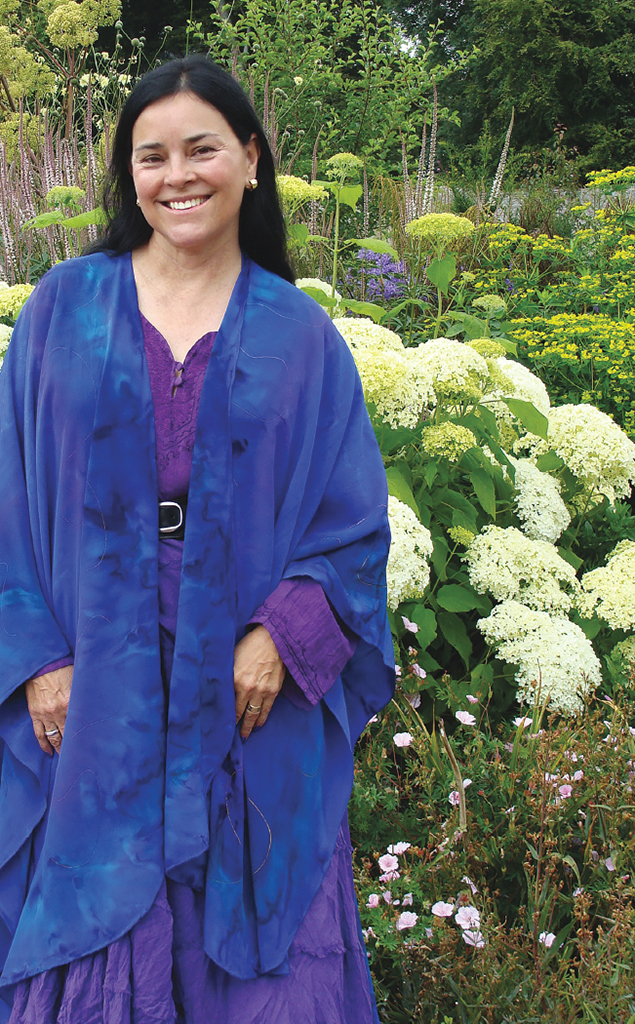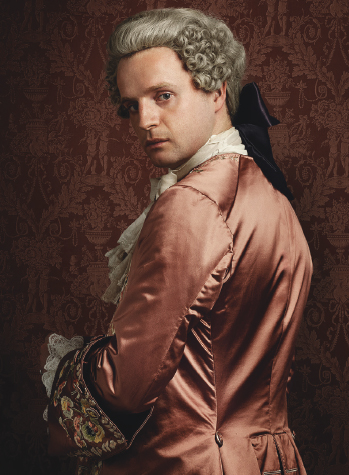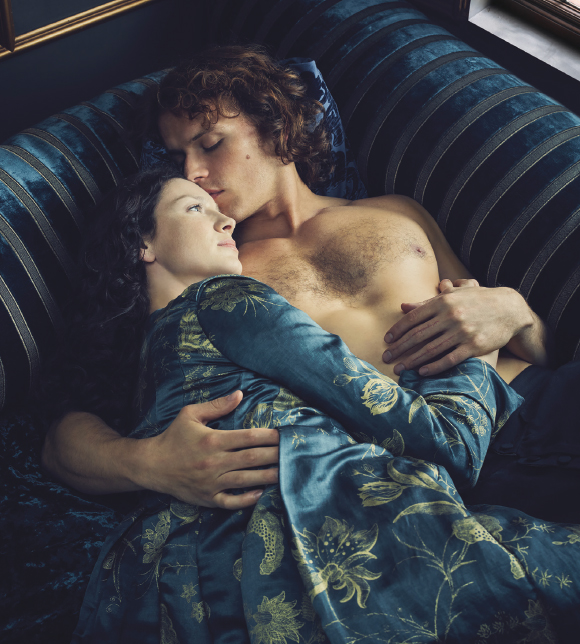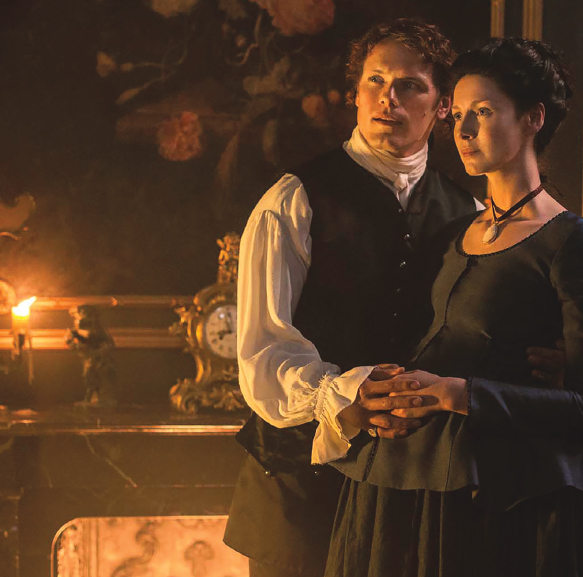
In the second season of the hit Starz drama, the Outlander lovers try to save Highlander clan culture by changing time itself–and in the process, provide an extraordinary history lesson on the Jacobite Rebellion and Scotland in the 1740s (for more of that history, read Dana Huntley’s Jacobite overview).
The show–and the book series on which it’s based–is a mix of action, romance and, of course, period drama. World War II nurse Claire, along with the audience, steps back into a dangerous, captivating past, an era that’s been beautifully reconstructed through meticulous research. “It’s just a taste for detail, I suppose,” says author Diana Gabaldon humbly. Here, she talks to British Heritage Travel about seeing her novels adapted, her new favorite scenes and how the Battle of Culloden is like the Death Star.

ELENNA LOUGHLIN
Diana Gabaldon: No, it’s deeply interesting. I think they’ve done a fabulous job. The actors are absolutely wonderful! They’ve done a great job at embodying the chacracters.
BHT: Were you prepared for the overwhelming response? I saw the first Outlander novel in castle gift shops throughout Scotland this past summer.
DG: Oh, that’s great! Yes, Outlander was published in 1991, and the books have been around for quite a long time, and have been successful in that time. Having a TV show, of course, gives them an extra level of visibility, which is very welcome in both directions. Fans of the books are automatically interested in the show and people who’ve seen the show are somewhat interested in the books. I’m pleased they’ve given the books an extra boost.
BHT: You have an academic background. Was that helpful for writing historical fiction? I imagine being trained in how to do intensive research is advantageous.
DG: Yes, I’d always known that I was supposed to be a novelist. I just didn’t know how. I decided, oh, I’d better write a book. And I thought, well, perhaps historical fiction, because I was a research professor; I knew my way around a library. It seemed easier to look things up than to make them up, and if I turned out to have no imagination, I could steal things from the historical record, which works pretty well.
BHT: Is the biggest challenge aligning characters and plots with real-life history?
DG: It depends on your focus. Some works are centered very much on the fictional character, whereas other types are centered on the historical event. Others are kind of a cross. Mine is a deeply personal story of these particular people and the circumstances in which they find themselves. Because of Claire’s position as a time traveler, given her knowledge of historical events, they have much more sensibility regarding these events. Something hideous is about to happen. She already knows about it, and can explain, both to her husband and the audience. That focuses the attention on what you might call the movements of history, and to some extent the personalities.
For instance, the Jacobite Rebellion was centered very much on the personality of Charles Stuart. Without him, it wouldn’t have advanced at all. There had been several Stuart restoration attempts prior to that, and the Jacobites had pretty much given up until the Prince got a bee in his bonnet and said, “Well, I’m going to do this!” He had enough personality, charisma, and stubbornness to actually do it.
[caption id="" align="alignleft" width="349"]

BHT: Since you mentioned the Jacobite Rebellion, season two has Jamie and Claire working to prevent it–and the Battle of Culloden–even though Jamie is actually a proud Scot who supports the rebellion.
DG: Well, he might, or he might not. In fact, it was not by any means a universally popular movement in Scotland. The Lowlands failed to support it entirely. They did not support the restoration of the Catholic monarchy at all, most of them being Protestant. It was only among the highland clans that the Stuarts found support. Even if they had succeeded, it’s very doubtful that they could have held the thrones of three countries, most of which were Protestant. The Catholic monarchy was deposed for a reason, and that was because of the growing Protestant influence in the British Isles. It was actually a religious civil war.
By no means were even all of the Highland clans in favor of the Jacobite rebellion. Many of them were against it on purely practical grounds, because they thought it would probably never succeed, and they were right. Others opposed it on religious grounds; many of them were Protestants, and others just were fearful of the effects. They said, “Well, no, we’re just going to sit this one out and see what happens.” It was not, by any means, a universally Scottish war.
BHT: Why was the Battle of Culloden was so devastating to clan culture?
DG: It’s because this was a fairly small-scale civil war, even though it would be important in its time. It took place over the course of six months, essentially, the military part of it. It had only three battles. The Highlanders won the first one decisively, won the second one less decisively, and then their support began to dwindle. It got later in the year. Their troops began to desert and go back home to take care of their crops. They were getting no financial support, and they were in bad shape. They began to turn back–headed back into the Highlands. At this point the Jacobite army was on the wane, and they were being pursued by a much greater British force.
They’re headed for the battle of Culloden, which crushed the rebellion successfully. A complete slaughter. It destroyed the Highland army, killed nearly half of the Highlanders that were on the field at the time. The rest of them were pursued and to a large extent captured, transported, hanged, etc. Not content with this, the British government then conducted an ethnic cleansing of the Highlands. Cumberland and his men went through the whole place torching crops, burning villages, shooting men, raping women–a complete campaign of terror. In the meantime, the British Parliament passed laws against any expression of Highland culture. The Diskilting Act of 1746 banned Highlanders from wearing tartans, possessing weapons, using bagpipes, speaking Gaelic, any of the external appurtenances of their own culture. It’s a great testament to the resilience of the Scottish spirit that they didn’t succeed, that that culture has in fact survived, because they certainly didn’t mean it to.
Anyway, Culloden was the beginning of this extirpation, you might say. Claire knows that, and therefore this particular battle has a very great significance, culturally and symbolically. That’s why their entire focus is on preventing that battle. But as they get closer and closer, it becomes less likely that they can.
[caption id="" align="aligncenter" width="580"]

STARZ
BHT: It feels looming in the distance from the start, that battle–like Greek drama, the unavoidably fated.
DG: It’s very symbolic. In fictional terms it does stand as this great menace. Most good stories are a story of good versus evil. In this case, the evil is set up symbolically as that battle, as like the Death Star in Star Wars. The thing that is always there. It is the continuing menace, and approaching as we go through.
BHT: I remember an interview where you spoke about how much you liked the wedding episode in season one. Any season two scenes that particularly moved you?
DG: I’d be hard-pressed to pick, other than there is deeply emotional, personal material having to do with Claire’s pregnancy in the seventh episode that’s remarkable, amazingly heartbreaking. Then later, during the rebellion, there are numerous very touching bits and pieces–some quite minor, and others fairly major plot points–so I’m not allowed to talk about it, of course, but it’s amazingly engrossing, let’s put it that way.
BHT: This season begins in France where Jamie and Claire try to cut off the rebellion’s financial funding, but are the Scotland scenes shot on location? The real places?
DG: They’re shot in Scotland for the second half of the season. Actually, most of the first half of the season is also shot in Scotland. There are parts of it that were shot in Prague, because modern-day Paris does not look anything like 18th-century Paris, whereas modern-day Prague does. Other Parisian scenes were shot in England, or in southern Scotland–in particularly beautiful locations that could pass for the Gardens of Versailles or whatever. The second half of the season, where we actually begin with the military parts of the rebellion, was shot entirely in Scotland, of course. I don’t believe they were using actual locations. They weren’t using the field at Prestonpans, for instance, or Culloden–and not only because these are historical monuments and they don’t usually let people film on them, but also for reasons of economy and logistics. It is really difficult, and hideously expensive to transport a production that involves 200 people.
[caption id="OutlanderAuthorDianaGabaldon_img3" align="aligncenter" width="655"]

STARZ
BHT: Do you feel the resurgence of historical fiction benefits our historical education?
DG: I’ve noticed this recrudescence, and the popularity of historical fiction seems to be rather cyclical. I think in this case it accompanies the aging of the population. Just as a person, you reach a point in your life where you begin to look backward and sort of evaluate your position in the world, and your generation, the state of the world now. You look back and you try to see: “How are we doing? What are things like now? How are they different?”
BHT: You received some very strong reactions after Dragonfly in Amber [the second book of the Outlander series, which season two is based on] came out. Are you expecting the same from TV fans?
DG: Probably not the same kind of strong reaction, but yes. It’ll be a fairly strong one. The reaction at the end of Dragonfly had been, “Where is the next book! I must have it right now!” I got death threats after it came out: “How could you end a book this way and not have the next one ready to go?” I expect something similar at the end of the show.
BHT: Are they following the structure of the book? Starting with Claire in her time telling the story?
DG: Well, they are ... not exactly. They are following basically the chronology of the book, but not necessarily the structure. The structure of the book is kind of unusual in that there is a framing story at the beginning and the end that kind of eclipses the twenty years between Claire's telling her daughter about these events and her return to what has been her present in 1948. That structure is not conducive to good television, good filming. As I told the executive producers when we were talking about it, I said, “I don't see how you would possibly film that, but if I were you, I would just disregard the framing structure and tell the main part of the story.” They didn't do that entirely. They did something different and something much more clever. The material of the framing story is in fact still in the second show, but it doesn't occur in the same place or in the same way.
BHT: You made Jamie part of Clan Fraser because you read in the history book Prince in the Heather that a Fraser was taken captive. Do you often let details of history guide you in that way?
DG: Oh, yes. I routinely pick up little interesting picturesque pieces. When it's a question of a character name, or a clan location, or something, I try to use legitimate details in that way.
BHT: Any chance of a spin-off of the John Grey novels?
DG: I certainly hope so. I am very fond of Lord John, myself, and I think he would make a great series on his own. We'll just have to see if anybody else thinks that too.
BHT: Will we continue past book nine?
DG: Yes, I'm not finished telling that story yet.
BHT: Why does 18th-century Scotland, a pretty brutal time, have such appeal?
DG: People often ask me that. I think it is because it’s a very beautiful but harsh time–and times of stress and conflict usually bring out the best in people. They also bring out the most interesting stories because of the things people have to do to survive–the ingenuity and so forth. In terms of romance, doomed causes are always romantic. The Jacobite cause is deeply romantic, because we know how it ended.
BHT: Can you tell us some of your favorite places in Scotland?
DG: The Isle of Skye, which is fabulous. My younger son-in-law, his family are the MacLeods from Skye, so we’ve been over there quite a bit. I also love Inverness. It’s one of my favorite small cities, and all of the places around there. I’m very fond of Orkney. And the Culloden battlefield.
BHT: The battlefield? That’s not too sad?
DG: No, it’s just deeply haunted. Very, very sorrowful, but very beautiful.
Outlander airs Saturdays at 9/8c. For more on the incredible Diana Gabaldon, visit her website and Twitter. To read an interview with the show's historical advisor, click here.





Comments